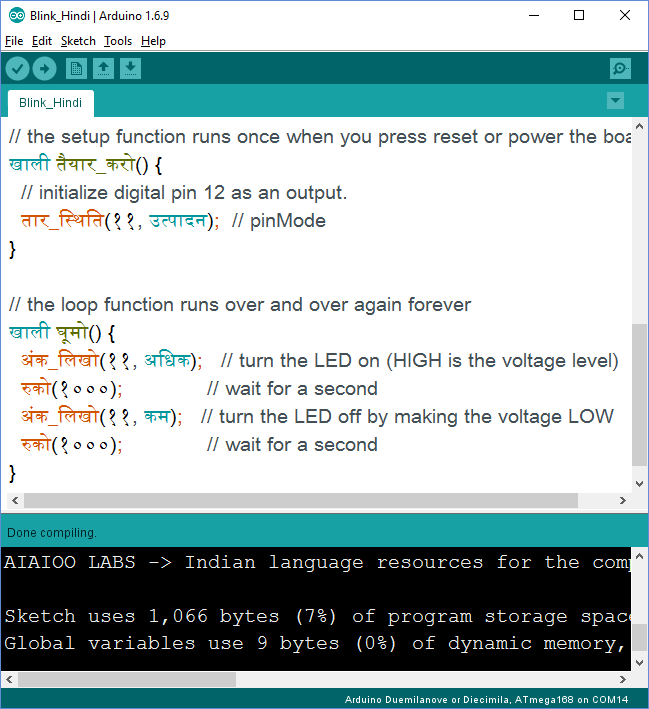For children who are taught computer science in Indian languages, conventional software programming can pose a challenge because most programming languages use the Roman alphabet.
We’ve created a way to allow students and teachers to write Arduino programs in Indian languages (at the request of Arduino India).
Arduino boards can now be programmed in Hindi and Tamil in addition to Kannada (as already described in an earlier post).
The Indian language extensions can be downloaded from our website.
These are the words used as replacements for English words: http://www.aiaioo.com/arduino_in_local_languages/
The website allows one to comment on and discuss the keywords picked as replacements for English words.
There’s still a lot of work to be done on the choices.
Very specifically, we’re looking for ways to simplify the words so that school children will find them easier to remember and type.
Any ideas for facilitating the learning process for children would be very welcome.
Illustrative Example
For example, we used to translate analogWrite as “ಅನಂಕೀಯವಾಗಿ_ಬರೆ” in Kannada, (“अनंकीय_लिखो” in Hindi and “அனலாக்_எழுது” in Tamil) using the coined word ‘anankiiya’ (negation of ‘ankiiya’ meaning digital) or the transliteration of ‘analog’.
However, during a discussion, a physicist who helped with the Kannada (thank you, Padmalekha) suggested that we use the phrase “write without spaces” for analogWrite.
And then it hit us that we could just use the phrase “write value” for analogWrite and “write number” for digitalWrite.
The following translations for analogWrite: “ಮೌಲ್ಯವನ್ನು_ಬರೆ“, “मूल्य_लिखो” and “மதிப்பை_எழுது” are much more intuitive.
The new translations for digitalWrite are also just as easy to comprehend: “ಅಂಕೆಯನ್ನು_ಬರೆ“, “अंक_लिखो” and “எண்ணை_எழுது”
The process of simplification is an ongoing one, and we hope in a few months’ time to have a generally agreed-upon set of translations, after taking everyone’s inputs into consideration.
Syntax
The Arduino IDE with extensions now supports syntax highlighting in Indian languages. This makes it easier to program in the local language.
This is how Kannada code looks:
Kannada Code

And here is how it looks in Hindi and in Tamil.
Hindi Code

Tamil Code


A innovative way to teach and understand programming. You are doing a great job by introducing translation sets in regional languages and specially for arduino platform. I would suggest writing a book in an simple, lucid manner which could teach pictorially and distributing a pdf/print versions for kids at school. Any kid with access to computers can then program these boards with help of simulators or real kits.
It would a great boon to the hardware manufacturing starved country like ours where many components are programmed and imported(mainly from China).
One more thing to consider is the intuitiveness that is arose in minds of people programming in their native languages.
I could volunteer to prepare a draft for Kannada language if the required permissions are granted by you guys. 🙂 Cheers
Thank you, Amit. The thing we’ve not been able to figure out about this method is whether it holds any advantages over using a tool like Scratch (the MIT visual programming environment). It seems to many that Scratch would be a perfectly acceptable alternative for children in local languages (Srishti has also been developing a local-language version of Scratch). We think there’s value in this anyway (because it’s simple and can be installed in local schools and operated without an internet connection, while the latest version of Scratch needs online access) but we’re not sure. We need to do a lot of studies with local schools. Do you work with any Kannada-medium schools? If we can do a study with some local schools, we’d be thrilled to work on this more seriously.
As for your offer to prepare a draft of a textbook for Kannada, of course we’d love that,and thanks for the offer! I’ve emailed you separately. You can respond to me directly.